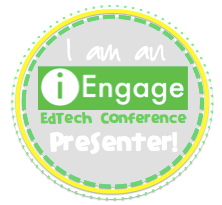Welcome to the Reading in the Wild book study! Thank you to Kristin, over at Reading and Owl of the Above, for hosting the study. She was a first-rate participant in the #ReadingStrategiesCrew book study I hosted on The Reading Strategies Book this past summer, which is why I was eager to jump on board her book study. We also both attended the Illinois Reading Conference in early October (along with a remarkable crew from our district) and listened to Donalyn Miller herself. Miller's session "Reading in the Wild: Learning from Lifelong Readers" was captivating and powerful, to say the least. In any case, check out Kristin's blog to read her pensive kickoff launching the book study of Reading in the Wild: The Book Whisperer's Keys to Cultivating Lifelong Reading Habits by Donalyn Miller.
 |
| Donalyn Miller alongside my district crew and me! |
Miller structures Reading in the Wild around five habits of, what she calls, *Wild Readers*:
- Wild Readers Dedicate Time to Read
- Wild Readers Self-Select Reading Material
- Wild Readers Share Books and Reading with Other Readers
- Wild Readers Have Reading Plans
- Wild Readers Show Preferences
This post reflects on the first habit of wild readers, which is dedicating time to read. Chapter 1 focuses on the importance of not just modeling reading for students, but modeling the love of reading. It starts out with, what I consider, a humorous and very relatable quote by Sherri Chasin Calvo: "If you have never said, "Excuse me" to a parking meter or bashed your shins on a fireplug you are probably wasting too much valuable reading time."
Has this ever happened to you? If so, you may be considered a wild reader. Wild readers are those who choose to spend substantial amounts of time in their day reading. If you are truly a wild reader, you find time for reading, despite your busy life.
Miller is the perfect example of a wild reader. She states she "reads for a living". As she gives us a glimpse into her life as a reader, Miller explains how she's the happiest when reading. Reading allows her to block out life's demands. She finds "daily solitude within the pages" of her books. Miller describes how she makes it a priority to carve out reading time in her day because it is something that matters to her. An author named John Green was quoted in this chapter saying, "Reading forces you to be quiet in a world that no longer makes a place for that" (2011). I love this quote. It's so true that life is filled with noise. What better way to tune it out with a good book?

Miller realizes, "Finding time to read requires commitment." As adults, allocating time in the day for reading can be tricky. We all have busy lives and very long to-do lists. Many of us have full-time jobs, children, a house to clean, clothes to wash and dishes to put away. Just as adults have obligations, so do students. Their to-do lists may include sports practice, doctor appointments, taking care of siblings, etc.
No matter the obligations, reading minutes can be found throughout the day, only if you are dedicated to finding time. I came across this quote on Twitter and instantly associated it with wild reading (and exercising).
If we truly want to influence students to be lifelong readers, we must find the time to become wild readers ourselves. We must model the habits of wild readers and share our reading excitement and experiences with students. Most teachers ask students to read at home on a daily basis, but don't read themselves, or share their own excitement about books with students. If you have excuses for why you don't read, so will students. The point being, we must *practice what we preach* to our students.
Miller provides suggestions to better support students' wild reading habits both at school and at home. She affirms "It is necessary to model, explicitly teach, and reflect on students' development of lifelong, avid (or, as I call them, "wild") reading behaviors to ensure that students remain motivated, engaged readers." Students can become wild readers when they begin to internalize reading habits.

According to Miller, teachers must set a reading foundation in the classroom before kids will internalize reading habits and become wild readers at home. She does this by carving out time in class for independent reading, passing books into her students' hands and discussing with students what they read. She shows her students how reading can enrich their lives, just as it enriches her own life. If students are part of a reading community at school, they begin to live like readers. They have the opportunity to exchange books with peers, share observations and impressions, as well as make book recommendations.
Miller suggests a fresh idea to use at the start of the school year called Status of the Class to support students in sharing about books. It's easy to implement, but is not necessarily used year-round. It's more of a "get reading routines started" type of activity which may be the first four weeks of school or after holiday breaks from school to jump start reading activity.
Miller states, "Students who don't read much or have lost their reading habit over the summer may not read much at first if we don't hold them accountable for their reading immediately." Status of the Class is a form students are required to fill out daily. Students then share their reading *status* with the class by using a "one-sentence, spoiler free summary of what is happening in the book" they are reading.
Generally, if students are given choice in the books they read, time for independent reading and access to wild-reading role models in school, the more likely they will fall in love with reading. If they fall in love reading, they'll most likely find time for it outside of the school day. Miller states, "Beyond racking up reading miles, ensuring that our students read everyday at school provides students opportunities to fall in love with books and develop stamina for reading."

Look below. Have you seen this Why Can't I Skip My 20 Minutes of Reading Tonight graphic before? I'm sure you have. It's an oldie but a goodie. As you already know, our classrooms are filled with a variety of readers, including those falling under the Student A, Student B and Student C columns. Student A readers are most likely those who enjoy reading, while Student B and C readers are just those still needing to discover a love of reading. It's never to late to become a wild reader! Once students are given time and support to fall in love with books inside the classroom, it's time to demonstrate to students how to dedicate time to read outside of the school day.

In order to gain valuable reading minutes, Miller suggests teaching students to take notice of times and places throughout their day when a "Reading Emergency" may occur, especially when the school day ends. A Reading Emergency is any stretch of free moments in a person's day that will allow him/her time for reading. For example, students may be waiting for the bus, standing in line at the store or sitting in the back seat of mom's car stuck in traffic. Encourage students to carry a book with them at all times. When they catch themselves bored, waiting or in a "Reading Emergency", pull out a book and read. Let students know these are valuable moments in their day that can be dedicated to reading! I actually caught a student wild reading outside of school the other day. Love it!

As I reflect on my own reading practices, yes, I've had a few excuses of my own every now and then. However, I do end up finding time to read! Yes, much of my hard-to-find time spent reading is dedicated to professional texts related to growing as a Reading Specialist and developing my foundational knowledge of best practices in Reading, not necessarily books filled with adventurous tales. I tend to save those for summer, since I have a little more leeway in my schedule. My point being, I do find time for reading, but it does take dedication.
Throughout my reading-binge moments, I have read ample research affirming the correlation of reading habits (or lack their of) and academic success. Because of this, my husband and I carve out anywhere from 30-60 minutes each night to read with our 4-year-old twins, in addition to making books available for Reading Emergencies. We make reading time an enjoyable, adventurous and worthwhile priority in our home. We desire our children to become wild, lifelong readers themselves. We definitely make use of our available minutes!

Overall, Miller has provided me with an even better understanding of what truly cultivates a lifelong reader. She has done much research supporting the importance of providing students with reading time in the classroom and at home. She gives justification to the findings the more students read the higher their reading achievement. Miller claims many classrooms are not developing wild readers, but if teachers do their part to demonstrate ways to become avid readers with our students, we will develop a classroom filled with readers in the wild!
Questions to Consider:
- What might be some ways you prepare yourself to support wild reading habits in your classroom?
- What do you want to be mindful of when trying to foster a love of reading inside and outside of your classroom?
Last, but not least, if you're interested in a convenient, downloadable resource, click the following link: Eight Ways for Parents and Teachers to Foster Wild & Lifelong Reading Habits. I came across this tip sheet and thought it would be worthwhile to pass along to parents, colleagues and fellow bloggers.
Don't own the book, yet? Here's a little sneak peek from Donalyn Miller herself. It may just be the nudge you need to acquire a copy for yourself. :)
Remember to follow along throughout the rest of the book study. The full schedule is below. Next up is Angela (my awe-inspiring mentee and outstanding first-year teacher) over at Miss G Does 5th. Her post on Creating a Workshop Schedule That Works for You goes live on Monday, November 16!
Happy Reading and feel free to link up your posts below! I will also gradually link the upcoming reflections of each chapter and vignette from the #D100bloggerPD participants for future reference.
P.S. Thank you to 3AM Teacher and Educlips for the solid green backgrounds, I Teach What's Your Superpower for the arrow image and Kimberly Geswein for the fonts used in my post images. :)


































































